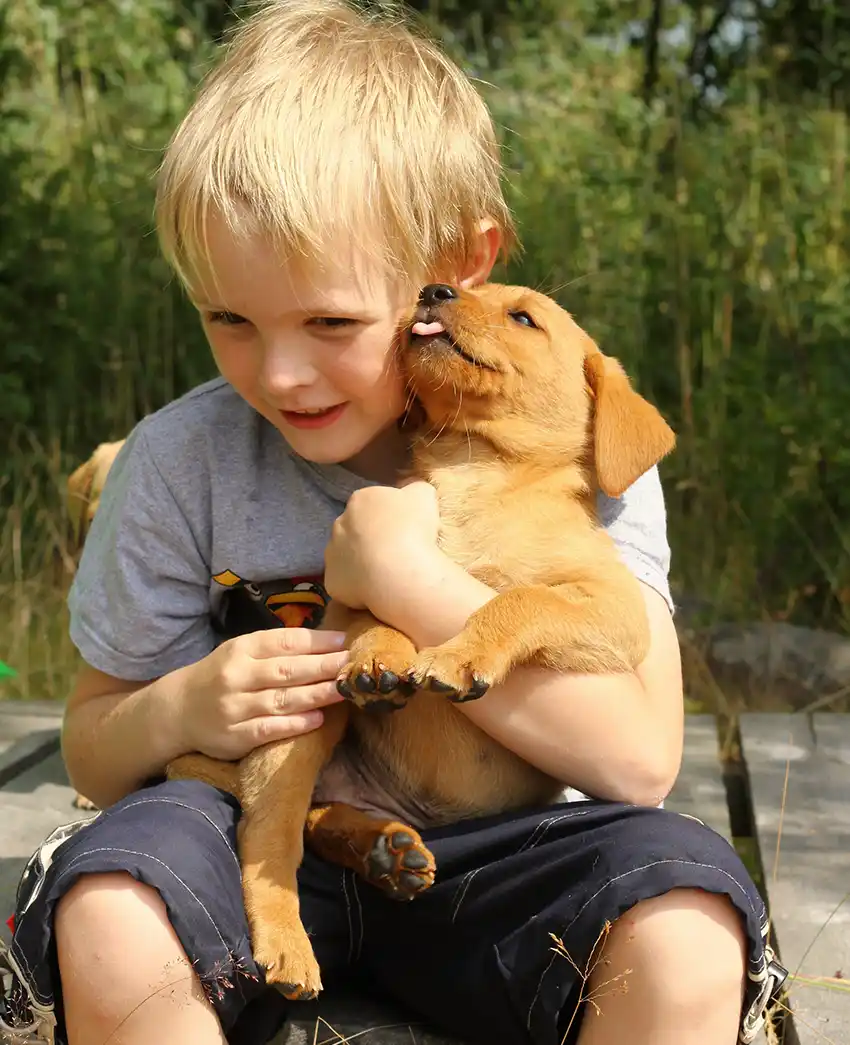The Labrador continues to rank as one of the most popular breeds in the United Kingdom, despite the emerging popularity of many other breeds such as designer breeds and toy-breeds.
Training
The Labrador still ranks as one of the most popular dogs within the United Kingdom. Why? because they are big and sweet and, in most cases, a great family pet. However, they are also the "top dog" when it comes to the need for training, and Bark Busters have trained many Labradors both in the UK and other countries around the world.
Although very trainable, they do need expert behaviour training and Bark Busters has a successful track record of training Labradors of all ages and with all kinds of behaviour problems. The Bark Busters training is the type of training that won’t suppress their personality or spoil their fun-loving nature.
Nowadays, dog owners understand the importance of locating kind and humane training for their pets, training that is dog friendly and fits into their time scale and training needs. Bark Busters has the Labrador ranked as #1 of the most trained dog breeds in countries such as the United Kingdom, USA and Canada and is still very popular in Australia, New Zealand and Spain.
The Love of Food
Labradors are loving, compassionate, and highly motivated dogs and one of their many traits is the love of food. These dogs are highly food motivated, which means that they will do anything for that food reward. It is important that we not over feed them as it can result in lameness of joints and diabetes, which are conditions related to obesity and over feeding.
Owners of Labradors, and Retrievers alike, need to be aware that the age at which they are neutered is important. If their pet reaches sexual maturity before being neutered, this will help later in life with obesity or weight gain. Females should ideally go through one or two heat cycles before being neutered, and males should be at least one year or older. It is important to monitor the quantity of food at each feeding. A contributary factor to obese or overweight dogs is caused by not measuring or weighing out the amount of food need to your dog's size.
Most dog owners buy treats from the pet shop but beware that these treats can contain high amounts of sugar, fat, and calories. There are many other alternatives to store bought treats. A few items that you might have in your refrigerator that you can give your pet are, carrots, green beans, apples, and peas. If a lab or retriever is part of a larger household or with children, it is important to explain that your pet doesn’t need treats from everyone. Instead give love and affection, which we all know labs and retrievers love, this will cut down on the number of treats.
Many thanks to Dr. David Randall for his Tip of the Month. David is from: Big Cypress Animal Clinic
Personality and Temperament
The breed has always been looked upon as the ideal family dog that possesses a stable temperament, loving nature and kid-friendly personality.
The outgoing, generally sociable Labrador ticks a lot of boxes when it comes to selecting the ideal family dog, but you need to do your homework and make sure you select the right personality and temperament to suit your lifestyle. Don’t select the over-exuberant puppy, if you love the 'great indoors'.
"Coco is very responsive to the training, life is much easier with these techniques. Thank you Bark Busters."
Labradors are a smart breed that are constantly training their owners. They can exhibit puppy behaviour for a liitle bit longer than other breeds and they are smart and need to be kept busy. The GameChanger® dog toy is a great tool for this breed as it keeps them busy and utilises their brain power.
Controlled Environment
To reduce the damage that a young Labrador can do to your precious things, you might want to create a safe, controlled environment. This place should be void of all your precious items and should be the place where you provide entertainment for your dog.

Four Basic Needs
Food - Select the right diet for your dog, one that possesses all of your dog's nutritional needs.
Shelter - A place to call its own, a bed of its own or a place where it can feel safe such as a den-like crate, that is warm and cozy.
Safety - Your dog’s feeling of security comes from Leadership and the fact that you as its leader will make all the decisions-you need to ensure you provide education and guidance for your dog.
Entertainment - Your dog needs to be entertained to reduce boredom. Toys and activities are essential to keep your dog stimulated and busy and to ensure that your dog is less destructive.
Behaviour Problems
Labradors do have their behaviour problems, but obsessive barking is not common to the breed. If they do have barking issues, it’s usually related to excitement and not aggression. However, Bark Busters trainers are often called in to help stop chewing, digging and over-exuberance characteristics, common to Labradors.
Labradors are very trainable, and they do need behaviour training so that problems do not develop. They are known to be tolerant of other dogs and children, but all play between dogs and a child should always be closely monitored.
It is the Labrador’s inherited attributes and the public’s perception of the breed that has led them to be excellent candidates for assistance dogs, seeing-eye dogs, therapy dogs, support dogs and scent detection dogs.
Labradors love company and get overjoyed at seeing new faces. This gets them jumping for joy while their powerful tails create a path of destruction among your furniture! Their bouncy, full of energy personalities are sometimes a challenge for their pet parents, but generally they are easy to train and capable of being trained to remain calm.
Socialisation
The best type of safe socialisation is with other dog parents who you know have a friendly dog. Socialising and introducing your dog to new sights and sounds is very important but it needs to be controlled. Introducing your dog to other "friendly" dogs is sensible and not intimidating towards dog and puppies.
The wrong kind of dog is one that is intimidating and possibly going to frighten an inexperienced puppy or dog and can cause long-term behaviour problems. Dogs do learn best from other dogs, but they can also learn bad habits too.
Dog Parks
If you are keen to take your dog to a doggy park, or places where there are many dogs, we recommend that you wait until they have reached 12 months of age. The concern about dog parks is the natural intimidation that some older dogs can display when they encounter puppies. This may leave your puppy with a long-lasting bad experience, which can later lead to behaviour problems, such as aggression to other dogs, as your puppy reaches maturity.
However, if fully immunised, you can sit with your puppy on your lap in a public area or park, where it can watch the world from a safe place. This way it won’t be intimidated or frightened by over-exuberant mature dogs or other older puppies.

Breed Traits
Labradors love retrieving but be wary if this behaviour becomes obsessive. However, do look for ways to enhance and harness this natural behaviour.
Their coat repels water to help monitor body heat while in the water and they have webbed feet which are ideal for swimming, but harder to get that lather up when bathing.
The Labrador is a breed that is generally slow to mature and can be destructive for some time, if not provided with sufficient entertainment or a worthwhile outlet for their intellect. Hiding toys, food / kibble, for your dog to find is an excellent way to train the brain and harness the natural scenting instinct. Select a controlled, enriched environment for your dog that can reduce this need, and provide all of your dog’s four basic needs.
Diet
Speak to your vet about the best diet for your dog or research online what might be the best diet for your puppy.
The breed tends to overeat and become over-weight, so monitoring and measuring nutritious portions is important. It is better to not let your dog graze and eat at will, as there could be no off switch and can lead to long-term obesity.
Energy levels
Over-exuberance is common amongst the breed, and this is the main problem we hear from many Labrador dog-parents. However, this breed is generally easy to train to settle and become calm. With correct training geared towards 'canine communication', the breed can easily be taught to be calm. Although rare, this over-excited behaviour can manifest itself into aggression if it is not addressed early.
Play Time
Child’s Play
The Labrador is a very popular family dog, and any play between a dog and a child must be monitored and controlled. Children have a way of getting dogs excited and this can lead to the dog inadvertently hurting the child through their natural excitable behaviour.
For safety, children should be taught to play sensibly and shown how to play games that are less likely to lead to over-exuberance. This could be hide and seek games or fetch the ball or toy games, versus the rough and tumble type of games. Rough housing will only encourage your dog to become over-excited every time it sees the children, and this can cause your children to try to avoid the dog because they fear getting hurt.

Adult Play
Any form of play, such as 'fetch the ball' and especially tug-of-war games, must end with you taking back control of the item. Once the game is over, take the item out of play, with a 'Finish' command and lots of praise.
This technique is designed to show leadership in a subtle way, that you are the decision maker, and that you control the game. This is important because we need to be the decision makers in the human dog relationship. If we allow our dogs to make their own decisions this can lead to unwanted behaviour problems.
Don’t play wrestle, rough and tumble, or hand games. These only teach our dogs to play rough and to bite when they play.
Encourage your Labrador to use their brain by hiding items that they can find, or play a controlled game of fetch, where you teach them to wait until they are allowed to fetch the ball or toy.
Puppy Selection
There has been an emergence over the last 20 years or so of two distinct types of Labradors, which we at Bark Busters refer to as "Traditional Labrador" and the "The new style Labrador".
We have no facts other than our own research conducted across the 7 countries where we operate, but we have seen a change in the breed style in the last 20 years.
We can only guess at why this has happened, but we feel that it came about when the Labrador became the go-to-breed for everything 'detection'.
This type of work required a dog that was acceptable at airports and capable of working for long hours, a dog that was highly energetic and willing to work longer and harder, with great enthusiasm.
Although the traditional Labrador has these traits, they more than likely did not have the staying power required for this type of work. This is evident in war zones, where the heat in some cases would be unbearable and where a leaner dog would fare better.

We believe their breeding took a turn in the road to breeding a high energy dog that was leaner, less prone to obesity, and a go-all-day type of dog, when they became the most popular breed for this type of detection work.
The indicator is evident in the fact that some of the guide dogs for the blind associations are breeding their own Labradors now that are more in keeping with what we refer to as the 'Traditional Labrador'.
The Traditional Labrador has shorter legs than the new-style Labrador, more body fat and a squarer body and head, and is less excitable and easier to train.
The new style Labrador has longer legs and leaner body, finer bones than the more traditional Labrador, elongated head and generally taller than the traditional Labrador, much more excitable and has extremely high energy levels.
Match the temperament of a puppy to that of your children
If selecting a family dog, be sure to match the dog’s personality to that of your child. An over-exuberant puppy can frighten a timid or gentle-natured child, so give thought to the type of personality that will match that of your children, or it could end in tears.
New Style Labradors
They are leaner and leggier, generally have finer bones and have a more elongated head than the Traditional Labrador. If you compared the two styles, you would see that the new style is taller and longer in the body.
Adolescent Labradors
Just like any other breeds, an adolescent Labrador can be testing for their owner, regardless of how well trained they are. It helps to be aware of this and act accordingly. It’s simple to resolve with leadership, balance, affection, and fair and just rules.
Games to Play
It is important to identify what type of games suit your dog. We recommend that you don’t play games that encourage biting or chasing, where you chase, wrestle, or tug of war, with your dog or puppy. These games encourage biting and running away, causing recall issues.
Puzzle and Treat Dispensing Toys
If you want to stave off destructive behaviours and keep your dog physically and mentally challenged, buy toys that slowly dispense treats to keep him occupied, prevent boredom, and help with separation anxiety. These toys can help your dog to direct its energy in a positive direction.
Chew toys and treat reward toys, such as the GameChanger® by Bark Busters, is a treat and chew toy all in one and a great way to stave off boredom. It also trains the brain too.

Caring for your Labrador
The Labrador’s short coat is easy to care for and always looks good.
As a water, retrieving dog, the Labrador’s coat is designed to repel water and to keep the dog warm while swimming. Think of it as a ‘wash and wear’ type coat.
Regular brushing is required, and we recommend that you only bath your Labrador when absolutely necessary as their coat will naturally repel dirt and grime. Too much bathing of any dog strips the natural oils and can create that doggy smell.
Genetic Conditions
If possible, check bloodlines or have a vet do an appropriate examination before you select a puppy or adopt your Labrador.
No dog with identified genetic faults should ever be used for breeding or you will just pass on genetic faults to their offspring.
Most modern-day shelters spay and neuter their dogs and conduct vet checks for medical soundness before placing them up for adoption. Visit your local shelter or rescue to see what great dogs they have available.
Choose reputable and registered breeders as they usually “score” their dogs, which means they have them X-rayed for common genetic faults and will be able to provide a score. If buying a puppy from a breeder, ask for the score results. Shelters and rescues won’t have these luxuries, but they are generally experienced at spotting obvious problems which is based on an informed opinion, and experience.
Bark Busters Lifetime Support Guarantee
Bark Busters dog behaviour therapists and trainers have trained more than 1 Million dogs worldwide and are renowned authorities in addressing dog behaviour with all-natural, dog-friendly methods. The Bark Busters training is the only service of its kind to provide International dog training guaranteed lifetime support. With hundreds of trainers around the world, Bark Busters continues its mission to enhance the human/canine relationship and to reduce the possibility of maltreatment, abandonment and euthanasia. Contact your local Bark Busters dog trainer to see how they can help.
This article is the copyright of Bark Busters® and is intended for information purposes only. Dog owners should fully research any problems that they may have with their dogs.
